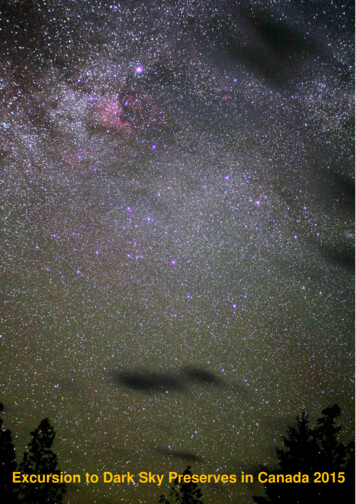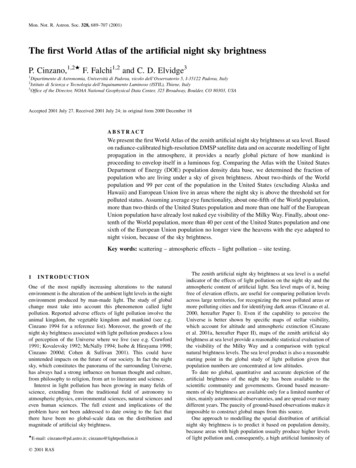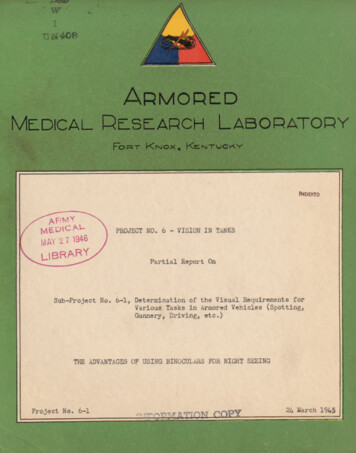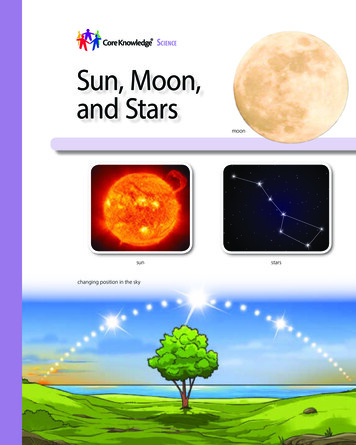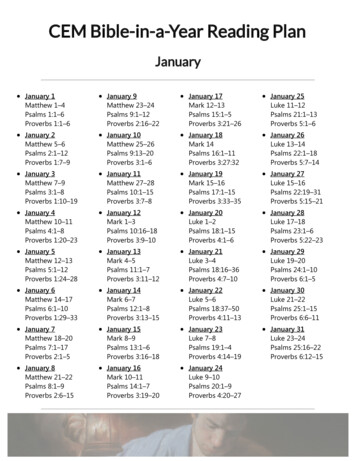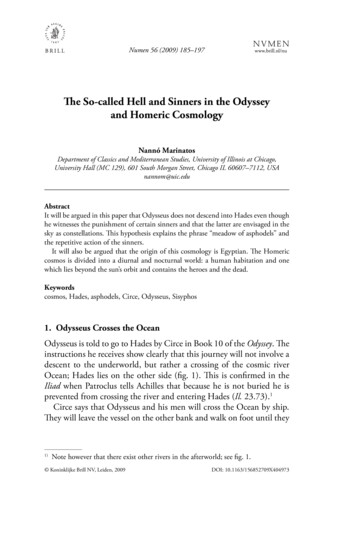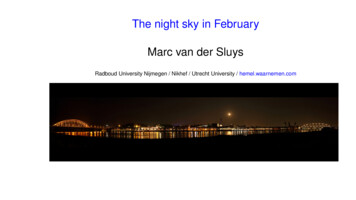
Transcription
The night sky in FebruaryMarc van der SluysRadboud University Nijmegen / Nikhef / Utrecht University / hemel.waarnemen.com
February 20221hemel.waarnemen.com2ISSFeb 4, 5, 7; Feb 19 ISS in February3The MoonPhases and apsidesConjunctionsPlanetsOverviewThe planets on theeclipticElongations of theplanetsMercuryThe visibility ofMercury (and Venus)4VenusDeep-skyOrion nebulaNext event5ISSFeb 4, 5, 7; Feb 19 ISS in FebruaryThe MoonPhases and apsidesConjunctionsPlanetsOverviewThe planets on the eclipticElongations of the planetsMercuryThe visibility of Mercury (and Venus)VenusDeep-skyOrion nebulaNext event
.waarnemen.comISSFeb 4, 5, 7; Feb 19 ISS in FebruaryThe MoonPhases and apsidesCurrent events in the night sky, easilyobservable or with a bit more effortVisibility of Sun, Moon, planets, meteors,comets, deep sky, ISS, . . .ConjunctionsPlanetsOverviewThe planets on theeclipticElongations of theplanetsAstrocalendars, sky maps, lunar phases,sky tonight, observing weather, tables, . . .Apps (Android/Apple), Twitter, (Facebook)MercuryThe visibility ofMercury (and Venus) 10.000 pages in Dutch; No adsVenusDeep-skyOrion nebula1–2 million visitors per yearNext eventThese slides on http://hemel.waarnemen.com/lectures
hemel.waarnemen.comhemel.waarnemen.comISSFeb 4, 5, 7; Feb 19 ISS in FebruaryThe MoonPhases and apsidesConjunctionsPlanetsOverviewThe planets on theeclipticElongations of theplanetsMercuryThe visibility ofMercury (and Venus)VenusDeep-skyOrion nebulaNext event
ISS transitsWhat? The space station ISStransits over theNetherlands.hemel.waarnemen.comWhen? Tomorrow and Mondayaround 18:20.ISSFeb 4, 5, 7; Feb 19 ISS in FebruaryThe MoonPhases and apsidesConjunctionsPlanetsOverviewThe planets on theeclipticElongations of theplanetsMercuryThe visibility ofMercury (and Venus)VenusDeep-skyOrion nebulaNext eventWhere? The ISS is coming from thewest-southwest andmoves low through thesouth to the east, where itwill become too faint to beobserved.And? These are the last transitsof this period, in theevening. The ISS willreappear starting 19 Feb,in the morning.http://hemel.waarnemen.com/iss/
ISS in Februaryhemel.waarnemen.comISSFeb 4, 5, 7; Feb 19 ISS in FebruaryThe MoonPhases and apsidesConjunctionsPlanetsOverviewThe planets on theeclipticElongations of theplanetsMercuryThe visibility ofMercury (and Venus)VenusDeep-skyOrion nebulaNext event
Lunar phases and apsidesNew Moon 1 Feb, 6:46.First Quarter 8 Feb, 14:50.Moon-phase calendarFull Moon 16 Feb, 17:56.Last Quarter 23 Feb, 23:32.hemel.waarnemen.comISSNew Moon 2 Mar, 18:35.Feb 4, 5, 7; Feb 19 ISS in FebruaryThe Moon28 Feb: last crescentPhases and apsidesConjunctions4 Mar: first crescentPlanetsOverviewThe planets on theeclipticElongations of theplanets11 Feb: apogee26 Feb: perigeeMercuryThe visibility ofMercury (and Venus)See also:VenusDeep-skyOrion cgiNext der.phpMore information: nemen.com/FAQ/Maan/004.html
Conjunctions Moon9/2: near the Pleiades (Taurus)10/2: occults 51, 56, 99 Tauri11/2: occults 103 Taurihemel.waarnemen.com13/2: near Pollux (Gemini)ISS16/2: near Regulus (Leo)Feb 4, 5, 7; Feb 19 ISS in February20/2: near Spica (Virgo)The MoonPhases and apsides21/2: occults 82 VirginisConjunctionsPlanets24/2: occults ρ OphiuchiOverviewThe planets on theeclipticElongations of theplanetsMercuryThe visibility ofMercury (and Venus)VenusDeep-skyOrion nebulaNext event24/2: near Antares (Scorpio)27/2: near Venus, Mars28/2: (near Mercury)1/3: (near Saturn)2/3: (near Jupiter)More information:http://hemel.waarnemen.com/astrokal/
The Moon near Mars and Venushemel.waarnemen.comISSFeb 4, 5, 7; Feb 19 ISS in FebruaryThe MoonPhases and apsidesConjunctionsPlanetsOverviewThe planets on theeclipticElongations of theplanetsMercuryThe visibility ofMercury (and Venus)VenusDeep-skyOrion nebulaNext event
The Moon near Mars and VenusWhat? The Moon is near Marsand Venus.hemel.waarnemen.comISSFeb 4, 5, 7; Feb 19 ISS in FebruaryThe MoonPhases and apsidesConjunctionsPlanetsOverviewThe planets on theeclipticElongations of theplanetsMercuryThe visibility ofMercury (and Venus)VenusDeep-skyOrion nebulaNext eventWhen? February 27, around 7:15.Where? In the constellation ofSagittarius, near thesoutheastern horizon.And? Mars is called the RedPlanet, but close to thehorizon and hard to see.Venus is the brightestobject in the sky, after Sunand Moon.More information:http://hemel.waarnemen.com/astrokal/
Overview planetshemel.waarnemen.comISSFeb 4, 5, 7; Feb 19 ISS in FebruaryThe MoonPhases and apsidesConjunctionsPlanetsOverviewThe planets on theeclipticElongations of theplanetsMercuryThe visibility ofMercury (and Venus)VenusDeep-skyOrion nebulaNext eventMore information: http://hemel.waarnemen.com/vannacht/
The planets on the ecliptichemel.waarnemen.comISSFeb 4, 5, 7; Feb 19 ISS in FebruaryThe MoonPhases and apsidesConjunctionsPlanetsOverviewThe planets on theeclipticElongations of theplanetsMercuryThe visibility ofMercury (and Venus)VenusDeep-skyOrion nebulaNext event
Elongations of the planetshemel.waarnemen.comISSFeb 4, 5, 7; Feb 19 ISS in FebruaryThe MoonPhases and apsidesConjunctionsPlanetsOverviewThe planets on theeclipticElongations of theplanetsMercuryThe visibility ofMercury (and Venus)VenusDeep-skyOrion nebulaNext eventMore information: http://hemel.waarnemen.com/planeten
Mercury morning starhemel.waarnemen.comISSFeb 4, 5, 7; Feb 19 ISS in FebruaryThe MoonPhases and apsidesConjunctionsPlanetsOverviewThe planets on theeclipticElongations of theplanetsMercuryThe visibility ofMercury (and Venus)VenusDeep-skyOrion nebulaNext event
Mercury morning starhemel.waarnemen.comISSFeb 4, 5, 7; Feb 19 ISS in FebruaryThe MoonPhases and apsidesConjunctionsPlanetsOverviewThe planets on theeclipticElongations of theplanetsMercuryThe visibility ofMercury (and Venus)VenusDeep-skyOrion nebulaNext eventWhat? The planeet Mercury is ingreatest elongation on 16February and acts asmorning star.When? Never, really. . .Where? As a dim ‘star’ in themorning twilight, low in theeastsoutheast.And? A (simple) pair ofbinoculars can help to findMercury.More longaties/mercuriuselongatie 20220216.html
The visibility of Mercury (and Venus)Maximum apparent separation from the Sun: Mercury: 28 , Venus: 47 onWesternEasternMorning skyEvening skyEastern horizonWestern horizonVisibility vourableFeb 4, 5, 7; Feb 19 ISS in FebruaryThe MoonPhases and apsidesConjunctionsPlanetsOverviewThe planets on theeclipticElongations of theplanetsMercuryThe visibility ofMercury (and Venus)VenusDeep-skyOrion nebulaNext eventMore information: http://hemel.waarnemen.com/FAQ/Planeten/014.html
Venus morning starhemel.waarnemen.comISSFeb 4, 5, 7; Feb 19 ISS in FebruaryThe MoonPhases and apsidesConjunctionsPlanetsOverviewThe planets on theeclipticElongations of theplanetsMercuryThe visibility ofMercury (and Venus)VenusDeep-skyOrion nebulaNext event
Venus morning starhemel.waarnemen.comISSFeb 4, 5, 7; Feb 19 ISS in FebruaryThe MoonPhases and apsidesConjunctionsPlanetsWhat? The planet Venus is ingreatest elongation on 20March and visible as themorning star — thebrightest object in the skyafter Sun and Moon.When? The planet is visible untilOctober, in the mornings,before sunrise.OverviewThe planets on theeclipticElongations of theplanetsMercuryThe visibility ofMercury (and Venus)VenusDeep-skyOrion nebulaNext eventWhere? As a very bright ‘star’, inthe east to southeast.And? With a good pair ofbinoculars or smalltelescope, the phases ofVenus can be seen(currently 20%).More aties/venuselongatie 20220320.html
Orionhemel.waarnemen.comISSFeb 4, 5, 7; Feb 19 ISS in FebruaryThe MoonPhases and apsidesConjunctionsPlanetsOverviewThe planets on theeclipticElongations of theplanetsMercuryThe visibility ofMercury (and Venus)VenusDeep-skyOrion nebulaNext event
Orionhemel.waarnemen.comISSFeb 4, 5, 7; Feb 19 ISS in FebruaryWhat? The constellation of Orionis a typical winterconstellation, best seen inDecember/January.When? Currently in the evenings.Where? In the southern sky.The MoonPhases and apsidesConjunctionsPlanetsOverviewThe planets on theeclipticElongations of theplanetsMercuryThe visibility ofMercury (and Venus)VenusDeep-skyOrion nebulaNext eventAnd? Easy to recognise, with thered giant Betelgeuse in theleft shoulder and the threebright blue young stars inOrion’s belt. The Orionnebula can be seen withbinoculars. Its distance is 1340 light years, and thestars are 10 000–100 000years young.Image: HST.More den/
Next public-observing/online astronomy nightWhat? Next public-observing nightat the Radboud University.hemel.waarnemen.comISSWhere and When (1)? Friday February25, in Nijmegen, if possibleFeb 4, 5, 7; Feb 19 ISS in FebruaryThe MoonPhases and apsidesConjunctionsPlanetsOverviewThe planets on theeclipticElongations of theplanetsWhere and When (2)? Friday March 4,online.And? New programme, newlecture, new nightsky, newdiscussion!MercuryThe visibility ofMercury (and Venus)VenusDeep-skyMore information: rgazing-evenings/Orion nebulaNext eventThis lecture at: http://hemel.waarnemen.com/lectures
Feb 04, 2022 · Mercury (and Venus) Venus Deep-sky Orion nebula Next event The Moon near Mars and Venus What? The Moon is near Mars and Venus. When? February 27, around 7:15. Where? In the constellation of Sagittarius, near the southeastern horizon. And? Mars is called the Red Planet, but close to the horizon and hard to s


